Understanding The Different Types of Bathroom Sinks & Basins

Bathroom sinks perform a vital part in our daily routines. Whether maintaining our personal hygiene or keeping on top of our skincare, we rely on our bathroom sinks to fulfil these necessary functions, while equally contributing to the overall aesthetic of our space.
There are a wide variety of bathroom sinks out there, each with their own style and method of installation, which can make choosing the ‘right one’ feel a little overwhelming, especially when you are trying to achieve a particular interior style. In this guide, we will cover everything you need to know before choosing the perfect sink for your bathroom, highlighting the features that differentiate each type of sink, from their designs to the materials they are made from, while providing some practical information to help decipher any technical jargon you may come across while browsing.
- How Do I Know What Size Basin I Need?
- What is a Bathroom Sink Made of & What Materials Are Available?
- What Are Tap Holes and How Many Do I Need On My Basin?
- What Are The Types of Bathroom Sink Available?
- Which Bathroom Sink Style Should You Choose?
- What Are The Shapes of Bathroom Sinks?
- What is Handing and Is it with all Basins?
How Do I Know What Size Basin I Need?
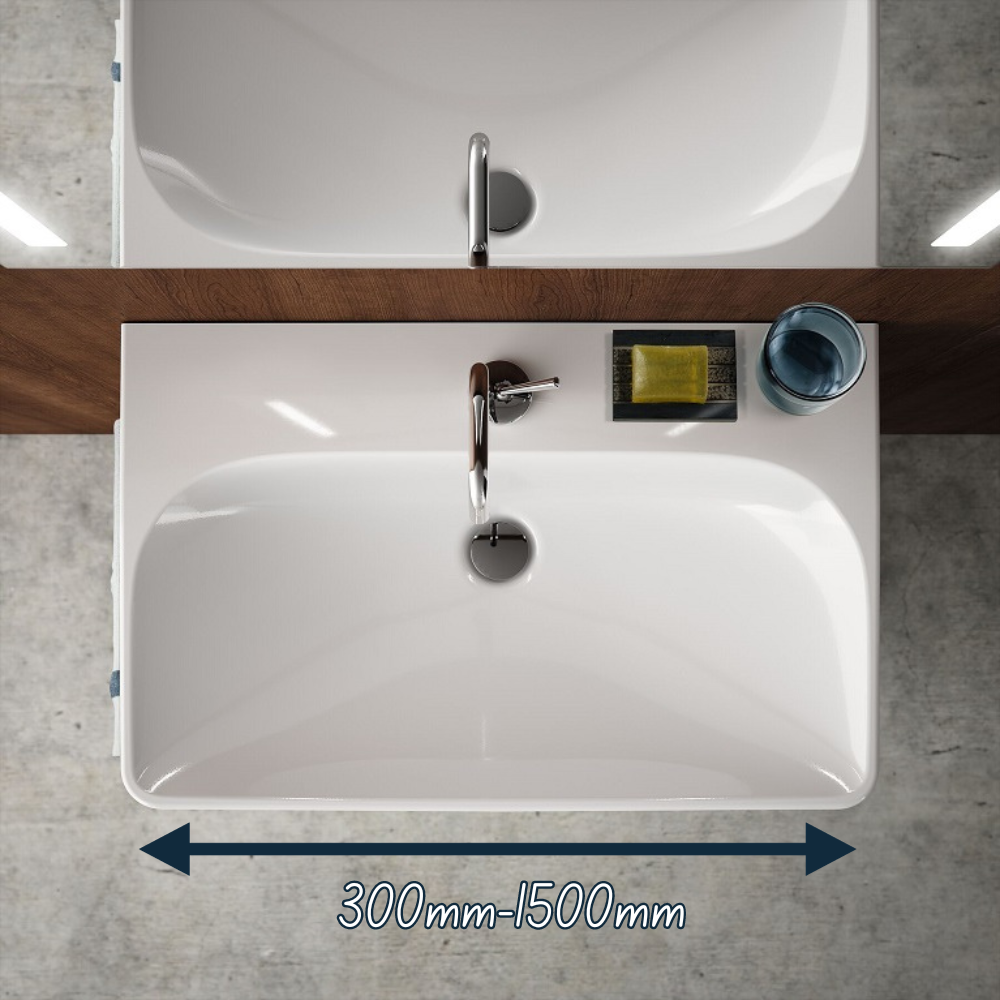
The first and perhaps most crucial decision you need to make is what size basin is best for your space. From petite bowls to vast trough-like rectangular basins, the width of a bathroom sink can vary between 300mm and 1500mm, but that is only one of the dimensions you need to consider. Depending on your chosen method of installation, the height of a basin will vary plus outward projection can be a deciding factor in more modestly sized bathrooms. So how do you decide which size you need for your home?
There are a couple of factors to consider, primarily:
- The size of the space that is being renovated.
- Whether you are just replacing your existing basin or completely changing the style and layout of your bathroom.
If you are undertaking a total renovation, then price might be another significant factor in your decision. While bigger basins generally cost more than smaller models, it is worth bearing in mind that in some instances, popular sizes are retailed at reduced prices due to the cost of manufacturing being cheaper. It is always worth comparing price points and looking out for special offers in the event that buying a bigger basin actually saves you some money, provided you have the space to accommodate it.
Choosing a Bathroom Sink to Fit The Bathroom Size
In the simplest terms, the size of the space should dictate the size of the basin.
Smaller spaces, such as cloakrooms and en-suites, benefit from bathroom sinks with narrow widths and short projections, which prevent the room from becoming crowded, claustrophobic and difficult to navigate. Thankfully, there are a subset of basins designed to work around spatial limitations. Commonly labelled or categorised as cloakroom basins, their defining characteristics are widths of 500mm or less, depths of 450mm or less, as well as the option of wall mounted or corner installation, which we will discuss in more detail later in the article.
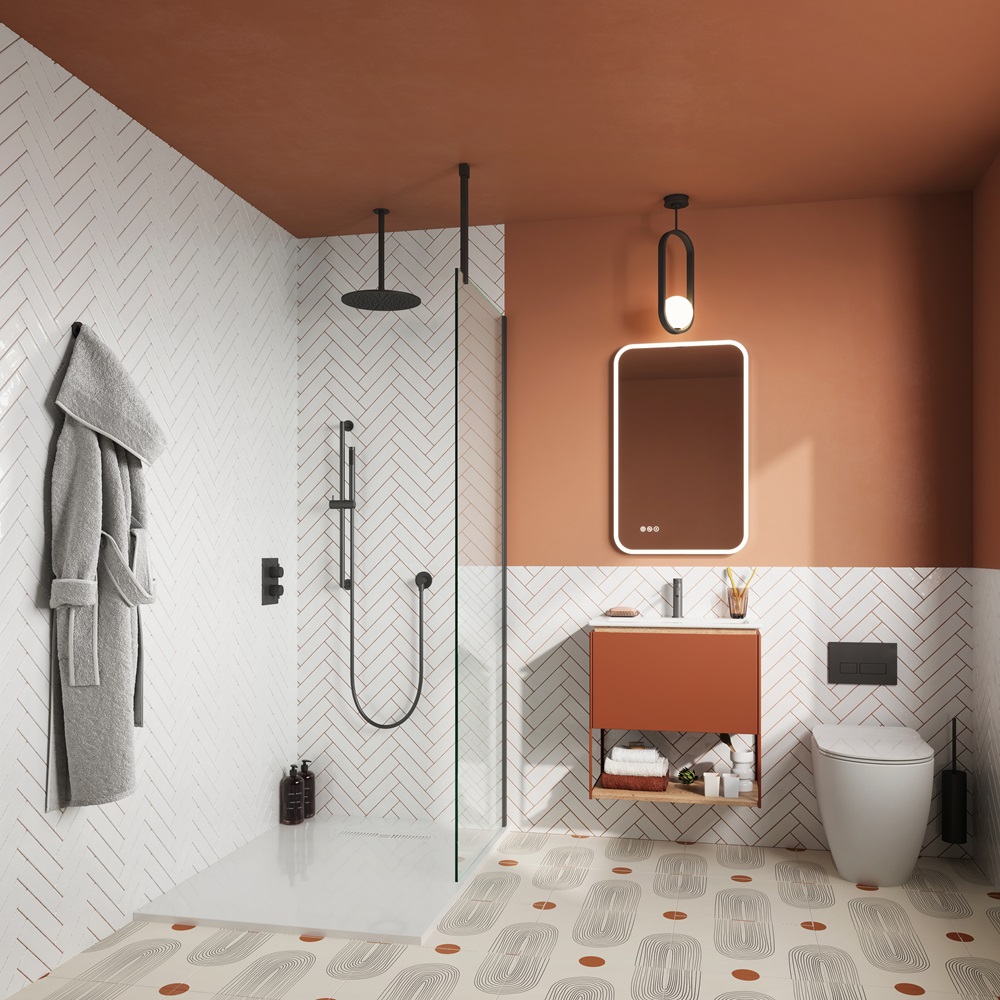
Larger spaces, on the other hand, allow you to be more flexible when choosing your basin. Free from the limitations posed by less floor space and subsequent lack of mobility, you can allow your functional and stylistic preferences to influence your decision. In an ideal world, the size of your basin should be dictated by how it can fulfil the needs and aesthetic of your bathroom, rather than restricted by the space available to you.
Bathroom Sink Refresh: Straight Swap or Full Revamp of Bathroom?
If you are happy with the rest of your bathroom and are simply looking to replace your current basin, a good way to determine how much space you have to work with is to consider your existing fixture: what type of basin it is; how it has been installed; what are the dimensions of space it occupies? While this is by no means an exact science, it will give you an approximate idea of the space available to you and whether there is any flexibility to increase it. That being said, we would strongly advise that you prioritise the accessibility of your toilet, shower and bath over the potential benefits of squeezing a larger basin into your space.
While this is less of an issue in larger spaces, it is often the case in smaller spaces that any new fixture will need to adhere to your existing layout. In cases such as this, which we have dubbed straight swaps, the dimensions of your new bathroom sink should near enough match those of your existing basin. However, this does not necessarily mean that your new basin needs to match the type or style of the previous. In fact, many homeowners faced with the straight swap feel compelled to use their space more effectively, combining multiple features (such as towel rails or under sink storage) to maximize the utility of their basin area.
If a full revamp is on the agenda, picking the right basin then becomes a question of the extent and the aims of your renovation. For larger bathrooms, introducing new fixtures into your design sometimes comes at the expense of sacrificing space and downgrading other fixtures to maintain accessibility across the space. For instance, if the crux of your renovation is replacing a shower bath with separate bathing and showering facilities, then you should prioritise the allocation of space accordingly, even if it means reducing the space for new your basin. By the same token, if you have your heart set on a particular basin and you recognise an opportunity to scale back another fixture to accommodate it, make the necessary adjustments to your space to turn your dreams into reality.
Maximising the utility of a smaller space is all about making these sorts of compromises, as well as effectively placing each fixture around the space so that you can squeeze in as much possible. Using a 3D bathroom design service can help you to visualise completely original configurations and make you more aware of the possibilities available to you.
What is a Bathroom Sink Made of & What Materials Are Available?
While almost every basin manufacturer has their own composite material that is unique to their catalogue, all of the materials that are used in the production bathroom sinks fall within one of the following three categories:
- Ceramic/Vitreous China
- Solid Surface
- Metals
Ceramic Basins & Vitreous China
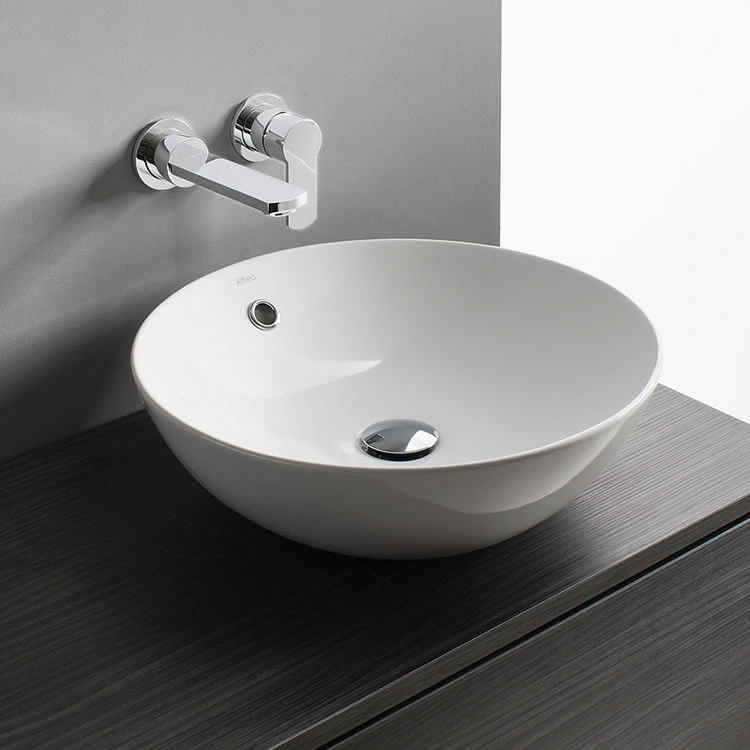
Ceramic Basins are the most common type of basin used in bathrooms. Ceramics are a form of pottery that is fired then glazed to provide protection and longevity, while offering other benefits such as affordability, recyclability and ease of cleaning. While ceramic basins are predominantly produced in white, they are available in a variety of different colours that can be achieved by mixing them with stains and oxides prior to firing.
Traditionally referred to as sanitaryware, some modern ceramic basins feature an enamel coating called Vitreous China, which increases their durability and lends them a glossier finish.
Solid Surface & Stone Resin
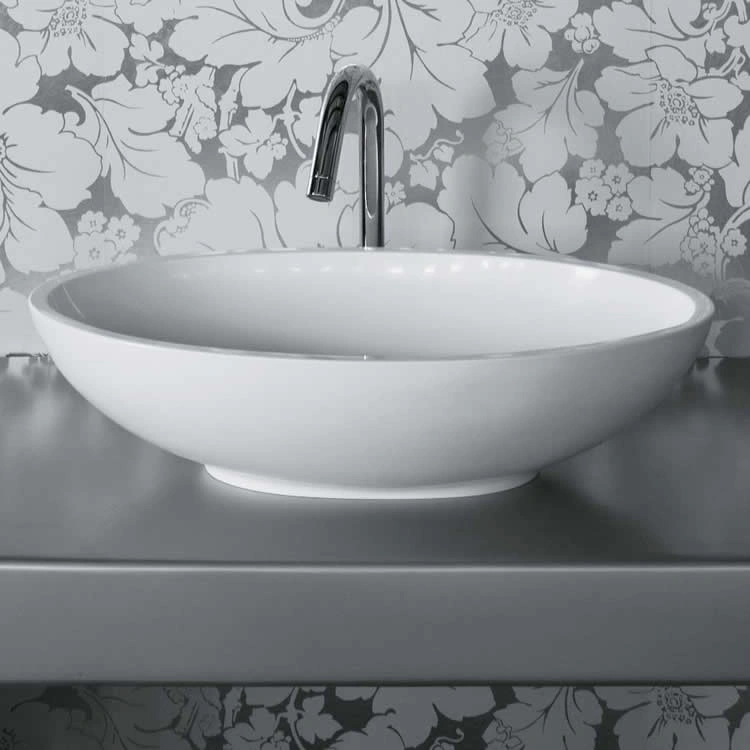
Solid Surface is a synthetic material made by combining stone resin with polyester resins and colour pigments, which is used to achieve the appearance of natural stone as well as a variety of other contemporary finishes.
While Solid Surface shares many of its benefits with ceramics, such as its durability and range of colour options, the material also boasts stain resistance, excellent heat retention and, while it can suffer from wear and tear like scratches, superficial damage can be easily buffed out using polish and a cloth.
Metal Basins (Brass, Tin, Stainless Steel)
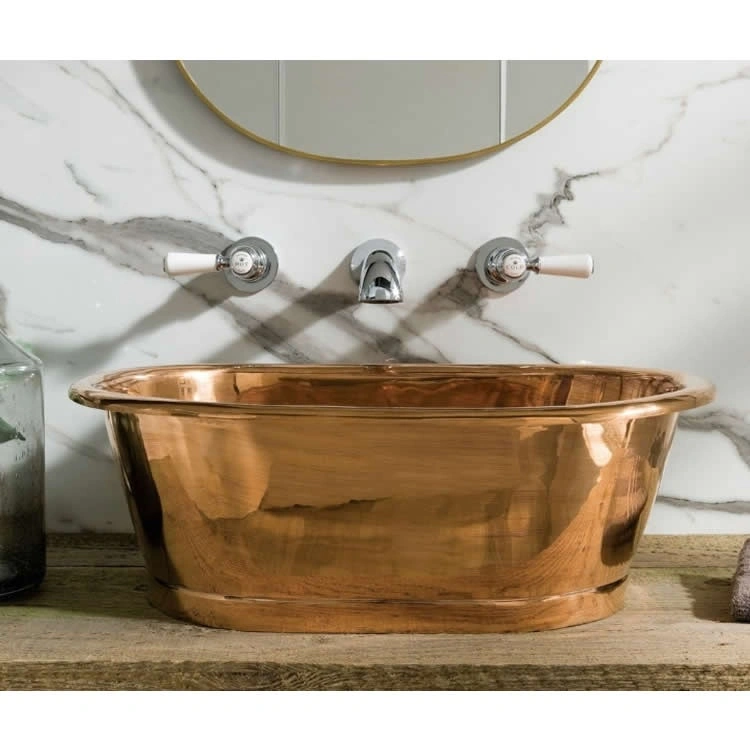
To achieve an industrial, traditional or even period style interior, metal basins are an authentic and striking option. There are numerous finishes available, among the most popular including brass, tin, stainless steel and nickel. Some metal basins are made from base materials such as copper then finished in a different colour, while others are made of and finished with the same material. Many manufacturers also produce metal freestanding bathtubs sporting the same finish as their metal basins, such that homeowners with the deepest pockets can achieve a consistent look across their space.
Metal basins also have the advantage of being an excellent conductor of heat, therefore retaining warmth much longer than ceramics or even Solid Surface. However, certain metals do require extra care in order to maintain their natural finish and to prevent oxidisation of the material.
What Are Tap Holes and How Many Do I Need On My Basin?
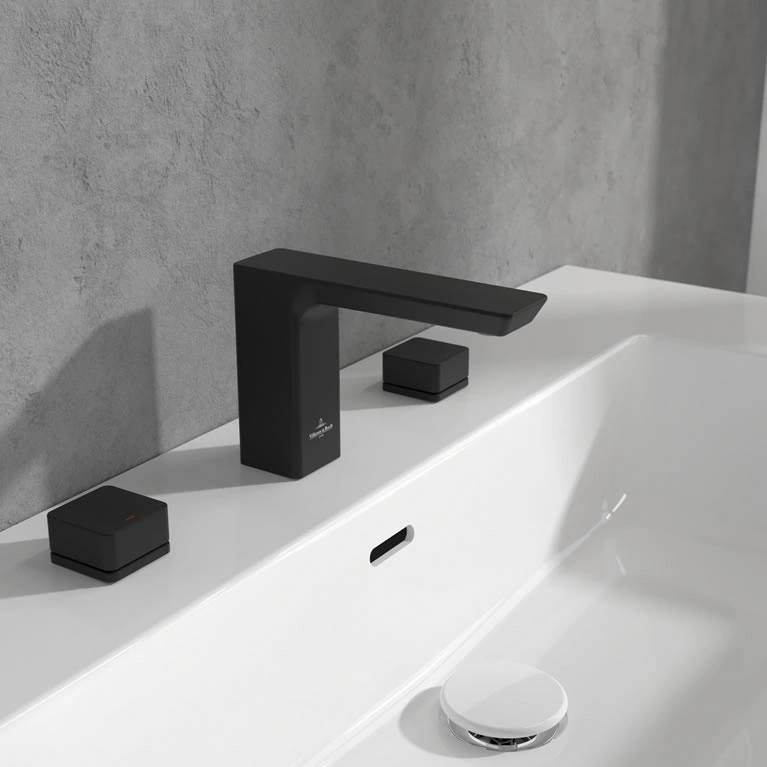
Another consideration that may dictate the type of basin in your bathroom space is the type of basin taps that you wish to pair with it. This will, in turn, dictate the number of tap holes you require on the basin.
Tap holes are holes that are drilled into a basin so that the tap can be fitted and connected to the water supply. For deck-mounted basin taps, which are installed into the basin itself or bathroom furniture, the number of tap holes on the basin itself can vary between 0 and 3.
No tap hole basins usually require a tall basin tap, which is installed on top of the furniture or surface that similarly holds the basin. One tap hole basins require mono taps, two tap hole basins require basin pillar taps or bridge basin taps, while three tap hole basins require a basin mixer tap with separate hot and cold water controls (as pictured above).
If you have wall-mounted basin taps, these should be paired with a basin without any tap holes. However, you should always check that the projection of your wall-mounted taps sufficiently reaches over your chosen the basin. While the length of a tap spout should not limit the type of basin it can be paired with, some combinations work better than others. This may sound obvious, but it is worth keeping in mind that, while your basin does not need to be drilled, the tap itself will still require tap holes to be fitted in either 2 tap holes or 3 tap holes, so make sure your basin in positioned below an appropriate section of your bathroom wall.
What Are The Types of Bathroom Sink Available?
Now that we have the basics covered, it is time to run through the different types of basins to help you to determine which one would be best suited for your space. There are 12 types of basin you are likely to come across, which are installed in different ways and lend themselves to different styles of bathrooms.
Full Pedestal Basins
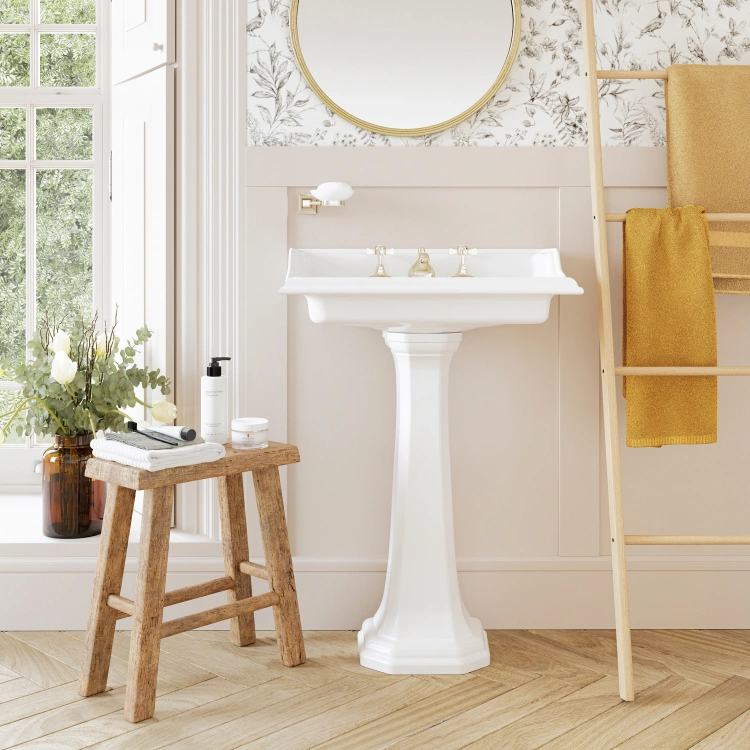
Full pedestal sinks are one of the most common and historically popular basins in the UK. These feature a basin that is usually sealed to a wall with a pedestal (which looks like a stand) running from the basin all the way to the floor. This gives the appearance that the basin is being held up by the pedestal, however it is there by design to hide the pipework and provide a tidy appearance.
While there is an unshakable sense of familiarity about the pedestal basin, which has contributed to its enduring popularity, more homeowners are moving towards more modern, abstract or convenient types of basin in their place. While they do come in modern and traditional designs, their style is synonymous with traditional style bathrooms. They are usually paired with deck mounted taps.
Semi & Half Pedestal Basins
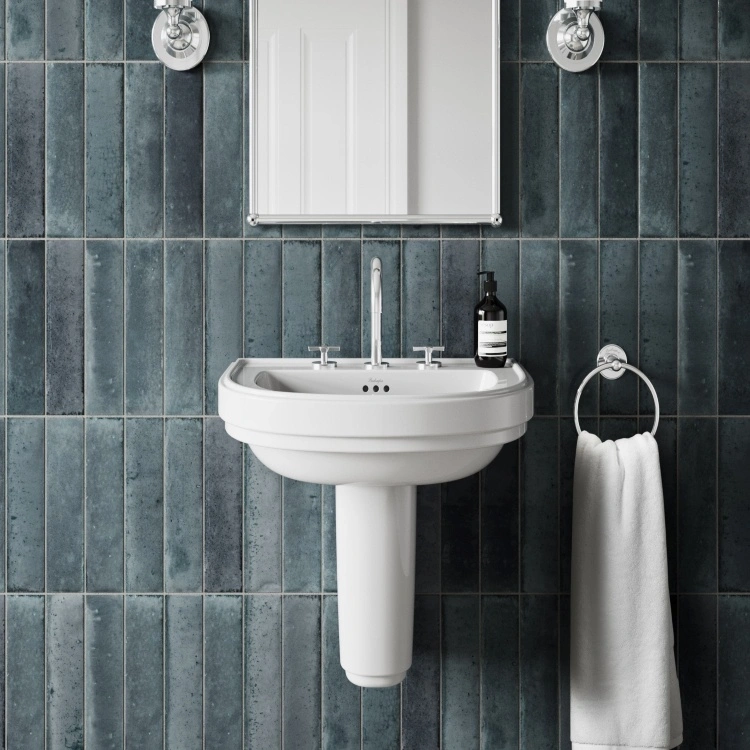
Semi Pedestal Basins, or Half Pedestal Basins, are wall mounted basins that feature cylindrical covers underneath them that perform the same function as a full sized pedestals, hiding the pipework and exposed bottle trap. These offer an excellent compromise for certain spaces, as they free up space underneath the basin to make a bathroom look bigger, while maintaining the traditional look of a full pedestal basin above. The cylindrical cover is often colour and style matched for a consistent look.
Wall Hung & Wall Mounted Basins
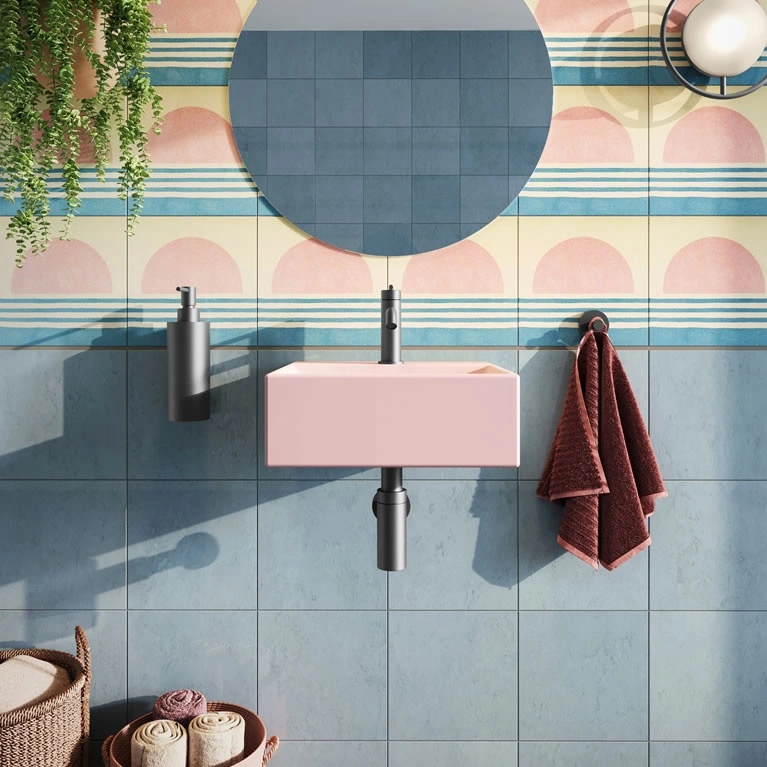
Wall Hung Basins are basins that are mounted to a wall using brackets or fixings that are installed onto wall to support it. They are among the most popular types of basin in contemporary bathrooms because of their ability to free up space for other fixtures, particularly storage, or simply to create the illusion of a wider bathroom space. They provide the perfect complement for other floating fixtures, such as wall hung toilets and wall hung cabinets, allowing you to take advantage of the height of your room as well as maximise the available floorspace.
They also have the benefit of being compatible with both deck-mounted and wall-mounted basin taps, offering incredible versatility when it comes to their installation. Some Cloakroom Wall Hung Basins also allow you to choose the handing of their taps, which means you can have a mono tap fitted to a tap hole on either the left or right side of the basin. (We will cover handing in more detailing later in the article.)
Countertop Basins
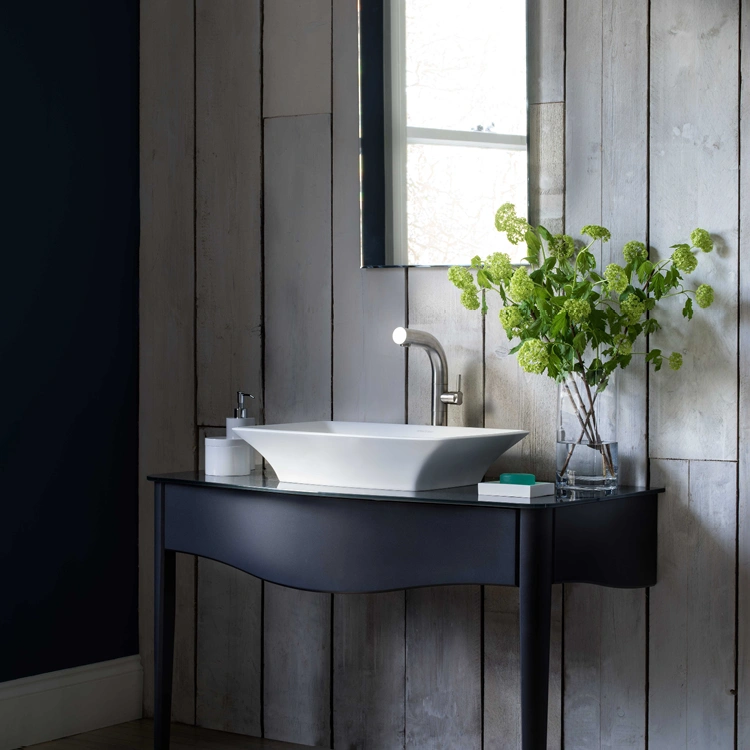
Countertop basins are really in vogue at the moment due to their versatile range of shapes, colours and designs. Sometimes called vessel sinks, these basins can be installed on top of any surface, such as countertops, worktops or even bespoke built bathroom shelves. They more commonly resemble bowls or troughs, depending on their shape, and are usually accompanied by tall basin taps or wall-mounted basin taps. Owing to their variety of styles and installation options, the countertop basin has come to epitomise the shift in bathroom design towards the Instagram-able and unique.
Vanity Basins & Units
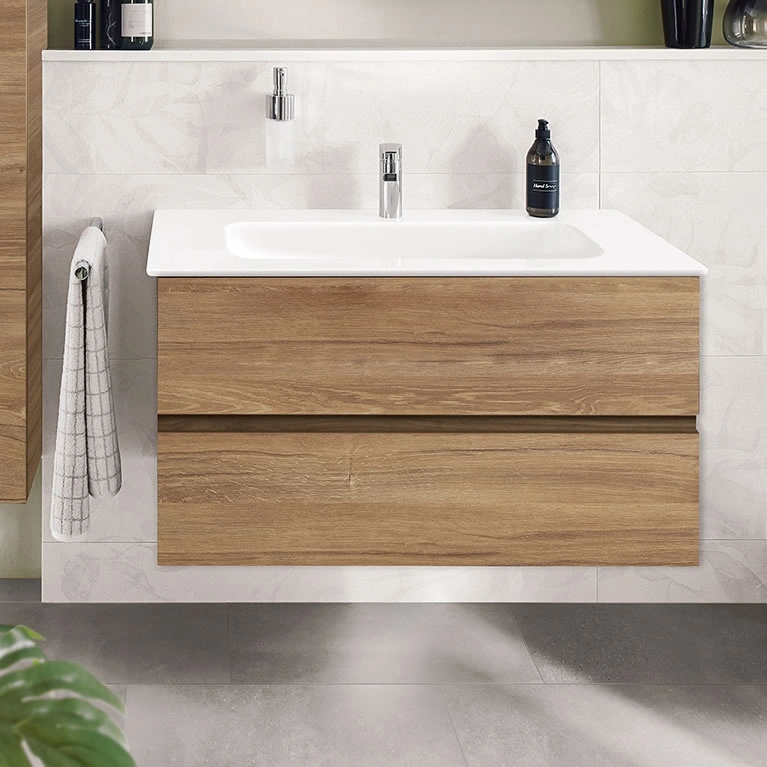
A vanity basin is installed into or on top of a piece of furniture, such as a bathroom vanity unit with a basin. They are ideal for households where space may be limited, as they combine sanitaryware and storage into one fixture. Typical vanity units often feature drawers or doors that open to reveal internal shelving, with the vanity basin built into the top. While most vanity units include a full vanity basin, which matches the width and depth of the unit itself, some incorporate a partial worktop surface, such as Carrara Marble, with an undermounted inset bowl.
While some vanity basins can be installed separately as wall-mounted basins, most are designed to complement the specific dimensions and aesthetic of their matching vanity units. Here at Sanctuary Bathrooms, vanity basins are always sold alongside their accompanying vanity units such that our customers do not have to waste time shopping around for the separate items.
Inset Basins – Drop In Basins & Flush Mount Basins
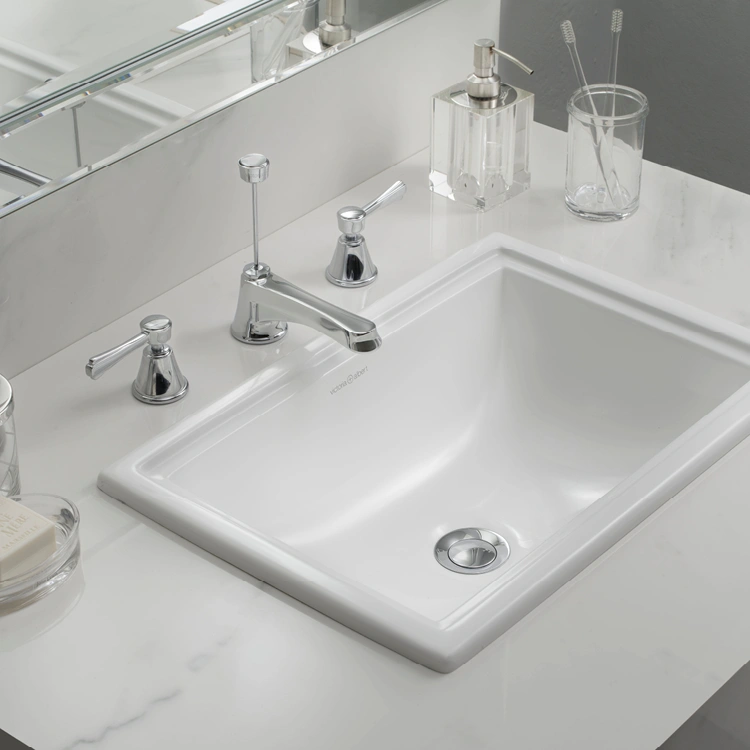
There are two types of Inset Basin, so we have separated them into their own sections to help differentiate between the two. Inset Basins are installed into worktops or unit surfaces and are most commonly seen in commercial properties featuring en-suites, such as hotels, bars and restaurants, although they are similarly suited to domestic en-suites. They are ideal for recreating a clean, contemporary hotel look at home and, much like the vanity units discussed previously, they are perfect for combining with storage.
The first type of Inset Basins we want to discuss are commonly called drop-in basins, although they are occasionally called flush-mount basins. As their name suggests, the basin is ‘dropped in’ to a pre-cut space in a worktop or surface, with the rim or top edge of the basin sitting on top of the surface. This is then sealed to prevent leaks while providing a tidy finish.
Inset Basins – Undermount Basins, Under-Counter or Countersunk Basins
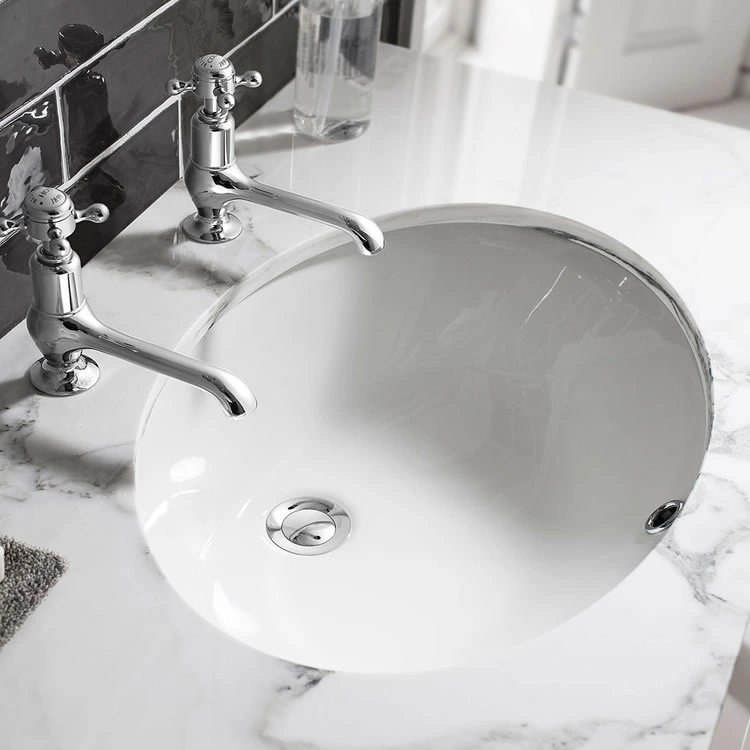
The second type of Inset Basins are called undermount, under-counter or countersunk inset basins. Stating the obvious again, as their name suggests, these basins sit underneath the worktop or surface, such that the only visible part of the basin is its bowl. It is worth noting that, because of their method of installation, the dimensions of the bowl will always be slightly smaller than the width of the basin as it is listed on our website, as this measurement is taken from rim edge to rim edge. As such, if you are looking for a particular size basin to fit your furniture, always consult the product specification documents to ensure that the dimensions of the bowl are appropriate for space you have.
Semi Inset & Semi Recessed Basins
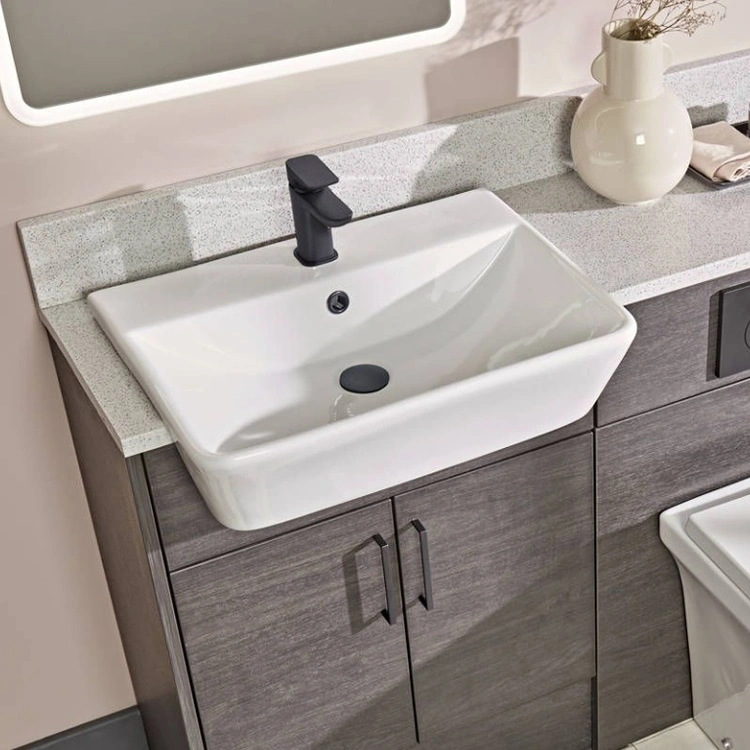
Semi Recessed Basins, or Semi Inset Basins, are basins that are partially installed into a surface or item of furniture. While the back of the basin is recessed into an area that has been cut out to accommodate it, the front is of the basin is left exposed and overlaps the front of your vanity unit or surface. Their design blends together elements of inset basins, vanity basins and wall-mounted basins, making it an ideal fixture for homeowners who like the look of traditional basins, but still want the convenience of under sink storage.
Corner Basins
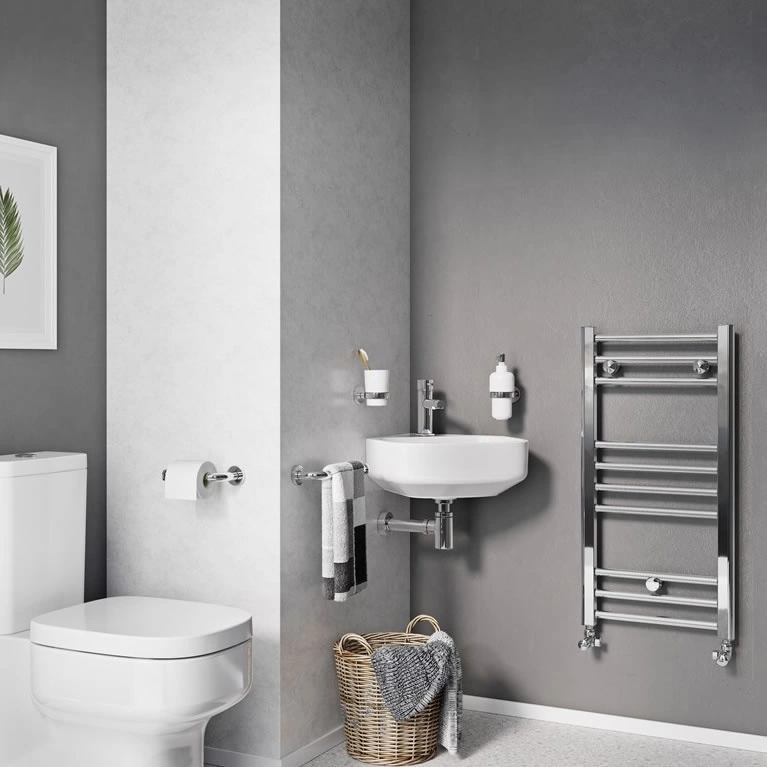
Less common but ideal for smaller spaces, corner sinks have an equal width and depth that allows them to slot seamlessly into the corner of a bathroom, or the intersection of two wall joins. Their convenient design allows you to maximise your wall and floor space, potentially creating space to accommodate extra storage or simply to make a space feel less claustrophobic. Available in a variety styles, including wall hung basins, pedestal basins and vanity basins for corner units, there a wealth of options to suit the needs and dimensions of your space.
Washstands & Console Basins
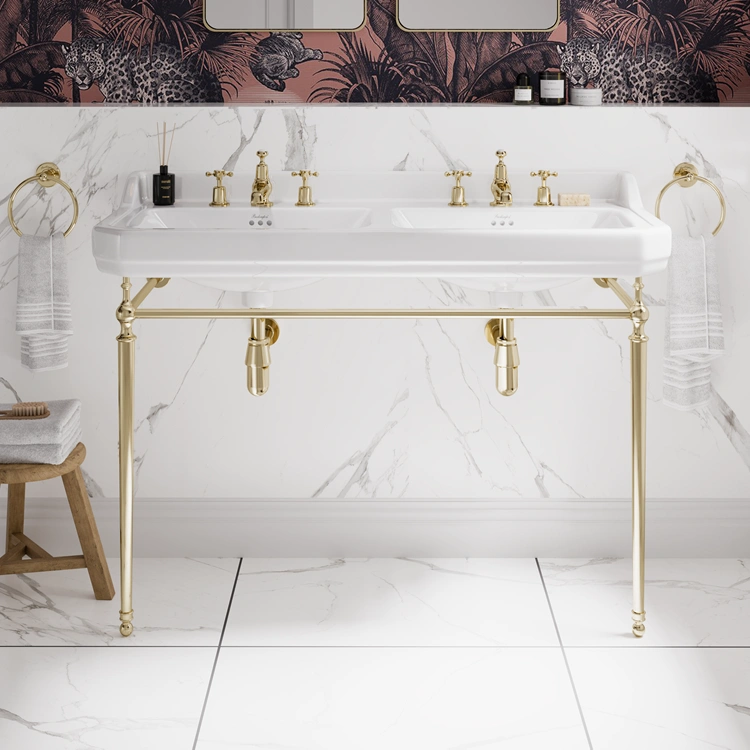
Washstands and Console Basins vary slightly but are essentially basins that are mounted to a frame with legs, or feature standalone legs. While traditional washstands and console basins provided an opulent alternative to classic pedestal basins, contemporary manufacturers have found ways to incorporate storage into their designs to achieve a more open look for your space.
Console Basins usually consist of a basin with two console legs, usually made of matching ceramic, whereas Washstands usually feature metallic frames in a coloured finish that can be matched to your brassware, or accent the wider aesthetic of your room.
Freestanding Basins
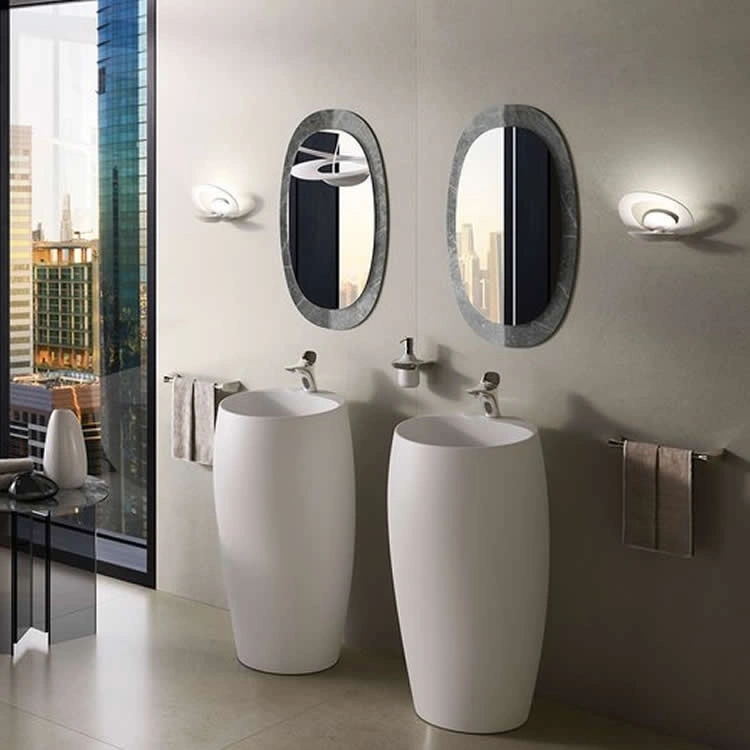
Freestanding Basins are perhaps the most unique type of basin, owing to their individual style and method of installation. Whereas every other type of basin is wall-mounted or mounted into furniture, these basins are the only ones that are floor-mounted or standalone. This means they can be positioned close to a wall for wall-mounted taps, or can be positioned more centrally in your space, with some brands advising that they be coupled with floorstanding bath taps. They come in a unique designs, including tubular, cylindrical and even barrel-like shapes.
As the waste is located in a bowl at the top of the freestanding basin, the waste continues through the basin all the way down to the floor. As such, installing one of these basins may incur additional fees, such as for lifting the floor to ensure the plumbing can be accommodated. It is worth speaking to a plumber or fitter before purchasing a freestanding basin to make sure it is suitable for your space.
Double Basins
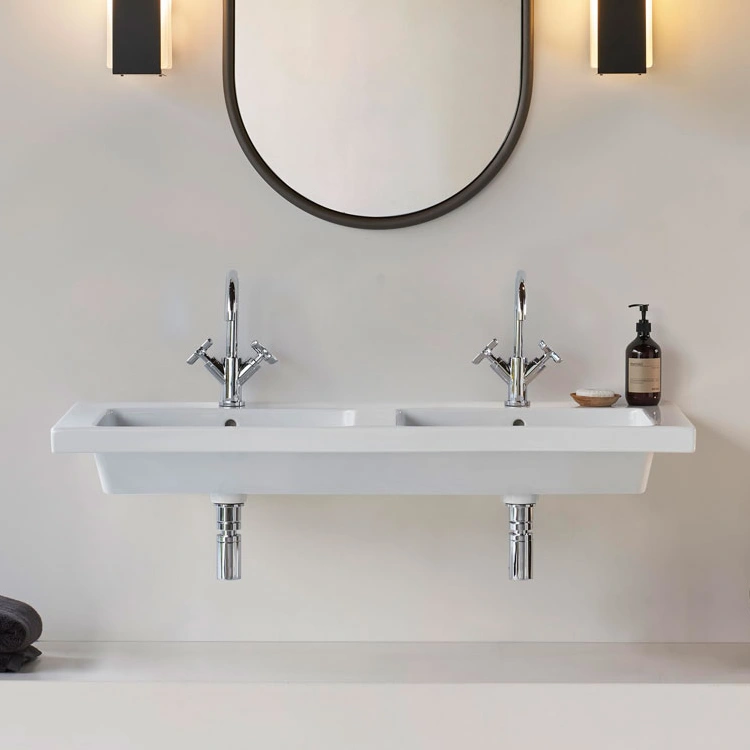
The final basin we have to discuss is the oft-sought double basin. This type of basin is only really suitable for larger spaces, due to their increased widths. Essentially, double basins include two bowls positions side-by-side, with two separate wastes and paired with two separate sets of taps.
Historically called ‘his and hers’ basins due to their design facilitating two people using the basin simultaneously, such as a couple, these basins are now universally promoted as being great for family bathroom spaces, where morning routines can clash and time is of the essence.
Which Bathroom Sink Style Should You Choose?
Many of the basins we have discussed come in both modern and traditional styles, so there is no one type that is more suited to one space or the other. We will cover some of the design features to look out for with each.
Modern Bathroom Sinks
Modern bathroom sinks tend to come in either simplistic, minimalistic shapes, with straight or smooth, curved edges. At the other end of the spectrum, there are innumerable unique and ultra-contemporary shapes. Modern spaces lend themselves to popular contemporary choices, particularly wall hung basins, semi or full pedestal basins and vanity basins, but with regards to the types themselves, there is a place for them all within modern designs.
Traditional Bathroom Sinks
Traditional bathroom sinks are much more uniform in their shaping, with more curves and stepped detailing included in their designs, replicating the shapes you would expect to find in period furniture and interiors.
Another common feature of traditional bathroom sinks is the upstand or backsplash (or splashback depending on where you look). This is a feature that is integrated into the basin, sitting at the rear like a little ceramic wall behind the tap. The point of this feature is to protect your bathroom wall from splashes of water, while incorporating the basin with the backsplash with your tiled walls or even reducing the amount of tiles you need.
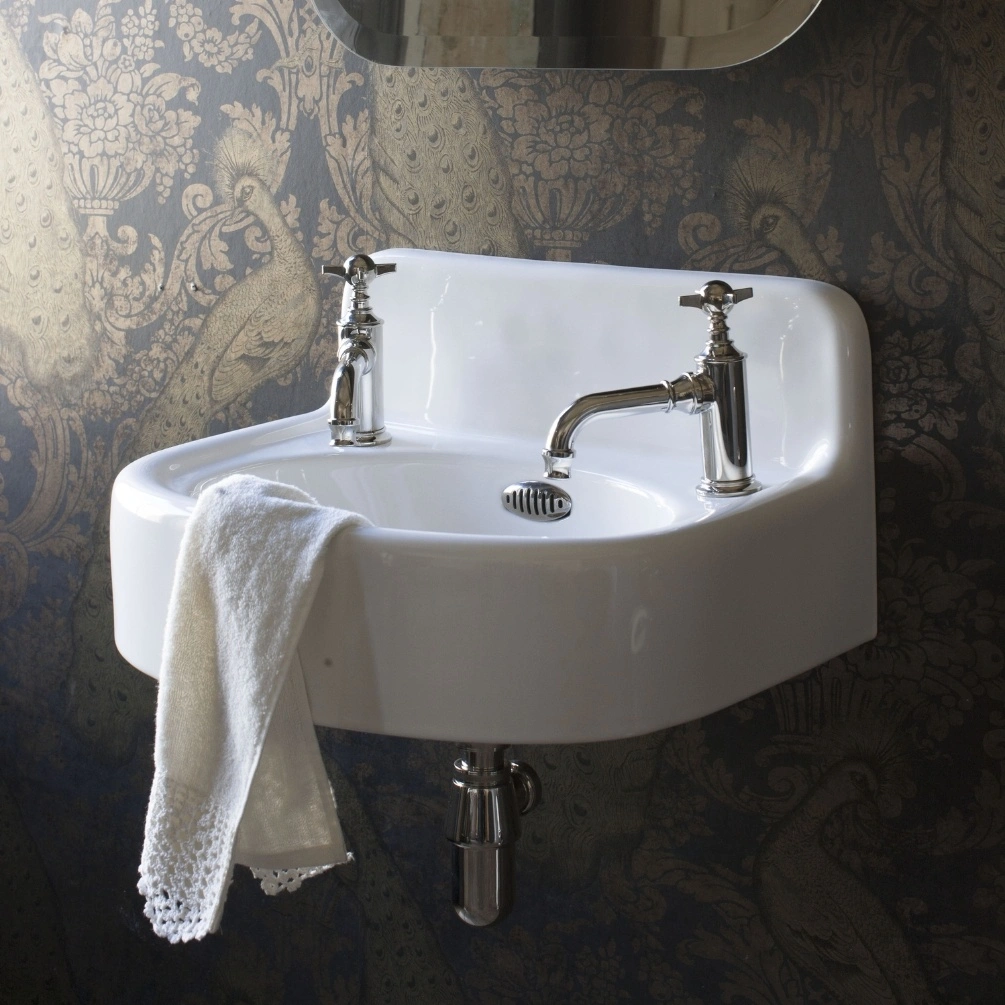
With regards to which basin you should pick for your traditional space, it really comes down to personal preference, as well as the interior style throughout the rest of your house. For some homeowners with older properties, keeping the traditional and rustic appearance of the home is important, while for others having a fresh and contemporary looking space is preferable.
What Are The Shapes of Bathroom Sinks?
Once you have chosen the size, style and type of your bathroom sink, it finally comes down to picking the perfect shape for you. While there are some unique bathroom sink shapes, including bespoke designs from certain manufacturers, we have chosen to focus the shapes that are most widely available:
- Rectangular – Wider than they in depth with straight edges.
- Square – Equal width and depth.
- D-Shaped/Curved - Basins that usually have a flat back edge and a curved front.
- Round/Circular – Perfectly round or bowl-like designs.
- Oval – Rounded design with longer width than depth (also called elliptical).
What is Handing and Is it with all Basins?
If you are on the market for a cloakroom basin, then there is one final piece of basin jargon that you may need to keep in mind: handing.
Handing is a common feature with smaller basins. Rather than having a centrally located tap, some sinks only have the space to accommodate a single tap, which is situated to one side. In this instance, most homeowners choose to locate their tap on the side corresponding to their dominant hand. As such, left-handed basins have their tap hole on the left and right-handed basin have their tap hole on the right.
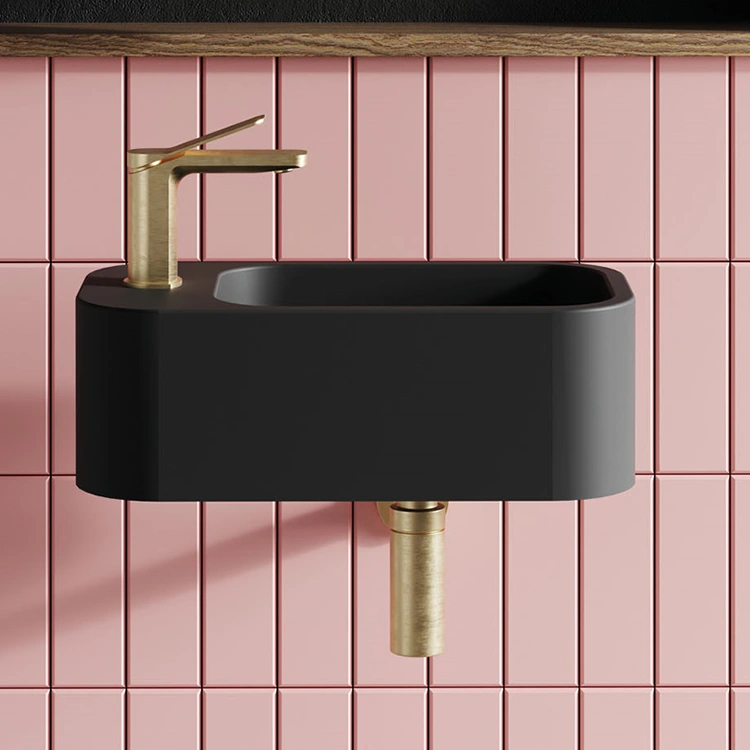
Some companies have made this slightly confusing labelling basins with their tap hole on the left as right-handed and vice versa, so it is always worth paying attention when buying to make sure the handing is the correct way that you want it. Simply checking the product specification documents to determine which side of the basin features the tap hole can help, or checking with the retailer ahead of your purchase to make sure it is definitely correct.
That concludes our guide to bathroom sinks. If you have any questions about any of the information in this article, or have any suggestions for something you would love to see added to this guide, please contact us and let us know.
